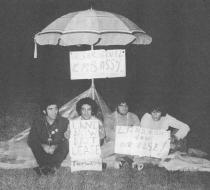Aboriginal Tent Embassy 1 Favorite
In the 1970s, inspired by the Black Power movement in the US, Aboriginal people were politically very active. In Sydney, Australia’s first Aboriginal legal and medical services were founded. Aboriginal people demanded land rights for the areas that they lived on since millennia.
Land rights were considered the key to economic independance, and land the base to generate resources and employment.
To many it came as a shock when in April 1971 the Northern Territory Supreme Court decided against Aboriginal people and in favour of a mining company to have access to Aboriginal land. Australian common law, the justice concluded, did not recognise Aboriginal land rights
Aboriginal people travelled to Canberra to ask the Prime Minister of the time, William McMahon, to give them title to their land, royalties from the mining operations, a right to consent to or reject further development on their land, and the land to be returned once mining operations finished.
The Prime Minister promised to look at ways to protect Aboriginal interests, but 9 months later, on the eve of Australia Day 1972, announced that, instead of granting Aboriginal people title to their land, his government would ask Aboriginal people to apply for new 50-year general purpose leases over such land. They would also have to prove that they put that land to ‘reasonable’ economic and social use. Aboriginal people had no title to mineral and forest rights
Angered by this announcement, Aboriginal people gathered in Sydney and decided that on Australia Day 1972 four representatives would travel to Canberra to protest against this decision. They were Michael Anderson from Walgett, Billy Craigie from Moree, Bert Williams from Cowra, and Tony Coorey from Tweed Heads.
The four erected a beach umbrella surrounded by placards in front of Parliament House proclaiming it an ‘Aboriginal Embassy’.
Because they had no rights in their own land the Aboriginal protesters thought that they were ‘aliens in [their] own land’ ]. As aliens they would need an embassy of their own.
In February 1972, in a desperate attempt to move on Aboriginal protesters the government tells them that it needs to “water the lawn”. Over the next days and weeks more and more Aboriginal people made their way to Canberra to join the activists at the Tent Embassy. A loophole in Australian Capital Territory lawsallowed camping on the laws of Parliament House as long as there were less than 12 tents, and the protestors took this to their advantage. Over the weekend of the 5-6 February 1972, members of the tent embassy drew up a petition to present to the government. In it they asked for full control of the Northern Territory including all titles to minerals, ownership of all other reserves and settlements in Australia including mineral and mining rights, preservation of all sacred lands in Australia, legal title and mining rights to areas of ‘certain cities’, and compensation payments for all other land taken from them.
Opposition leader Gough Whitlam visited the Aboriginal Tent Embassy on February 8 to discuss the petition.
But the government did not sleep. Hastily it drafted a new law banning camping on unleased Commonwealth land within Canberra. On July 20, just hours after the new law came into effect, police moved in violently and forcibly removed tents and arrested Aboriginal people. Within days the Aboriginal embassy population swelled to several hundred protesters who re-erected tents only to clash with police again.
By 30 July more than 2,000 Aboriginal people and their supporters had gathered at the embassy. On 13 September 1972, the ACT Supreme Court declared the removal of the Aboriginal Tent Embassy illegal because the law that underpinned it had not been notified ‘in the prescribed manner’. The embassy was re-established and remained on the lawns of Parliament House until 13 February 1975, when the Department of Aboriginal Affairs and the Minister for Capital Territory negotiated its removal.
On the embassy’s 20th birthday, 26 January 1992, it was set up again. By then the Parliament House was no longer used by the government which had moved to Capital Hill.
On 9 April 1995 the Australian Heritage Commission registered the Embassy site on the National Estate.
Over time, arson attacks have damaged or destroyed some of the structures on the site.
The Aboriginal Tent Embassy has become a lasting symbol of Aboriginal unity on land rights and sovereignty.
On 26 January 2012 the Aboriginal Tent Embassy celebrated its 40th anniversary, making it Australia’s longest standing site of political agitation.







